2015 NISSAN LEAF ECU
[x] Cancel search: ECUPage 108 of 412
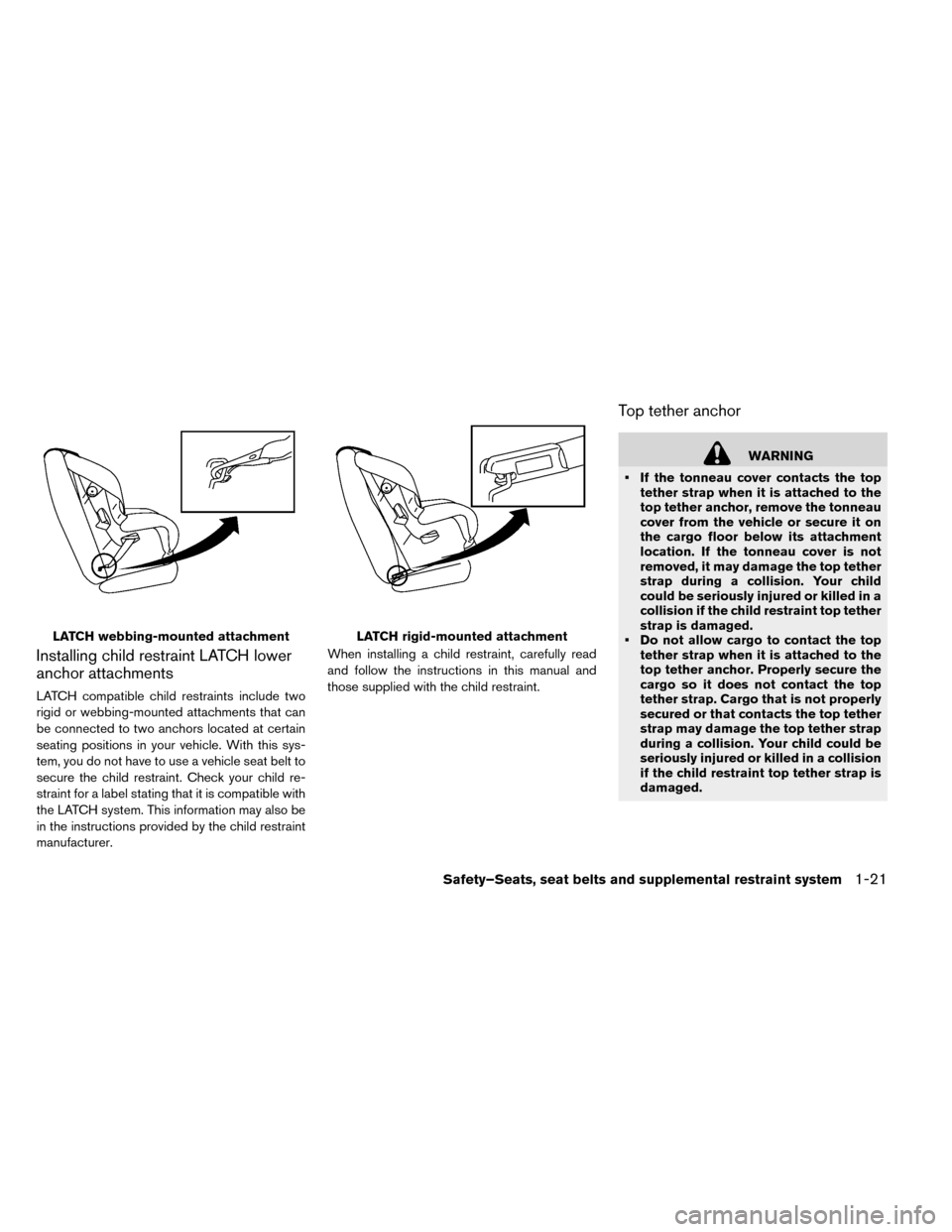
Installing child restraint LATCH lower
anchor attachments
LATCH compatible child restraints include two
rigid or webbing-mounted attachments that can
be connected to two anchors located at certain
seating positions in your vehicle. With this sys-
tem, you do not have to use a vehicle seat belt to
secure the child restraint. Check your child re-
straint for a label stating that it is compatible with
the LATCH system. This information may also be
in the instructions provided by the child restraint
manufacturer.When installing a child restraint, carefully read
and follow the instructions in this manual and
those supplied with the child restraint.
Top tether anchor
WARNING
• If the tonneau cover contacts the top tether strap when it is attached to the
top tether anchor, remove the tonneau
cover from the vehicle or secure it on
the cargo floor below its attachment
location. If the tonneau cover is not
removed, it may damage the top tether
strap during a collision. Your child
could be seriously injured or killed in a
collision if the child restraint top tether
strap is damaged.
• Do not allow cargo to contact the top tether strap when it is attached to the
top tether anchor. Properly secure the
cargo so it does not contact the top
tether strap. Cargo that is not properly
secured or that contacts the top tether
strap may damage the top tether strap
during a collision. Your child could be
seriously injured or killed in a collision
if the child restraint top tether strap is
damaged.
LATCH webbing-mounted attachmentLATCH rigid-mounted attachment
Safety–Seats, seat belts and supplemental restraint system1-21
Page 110 of 412
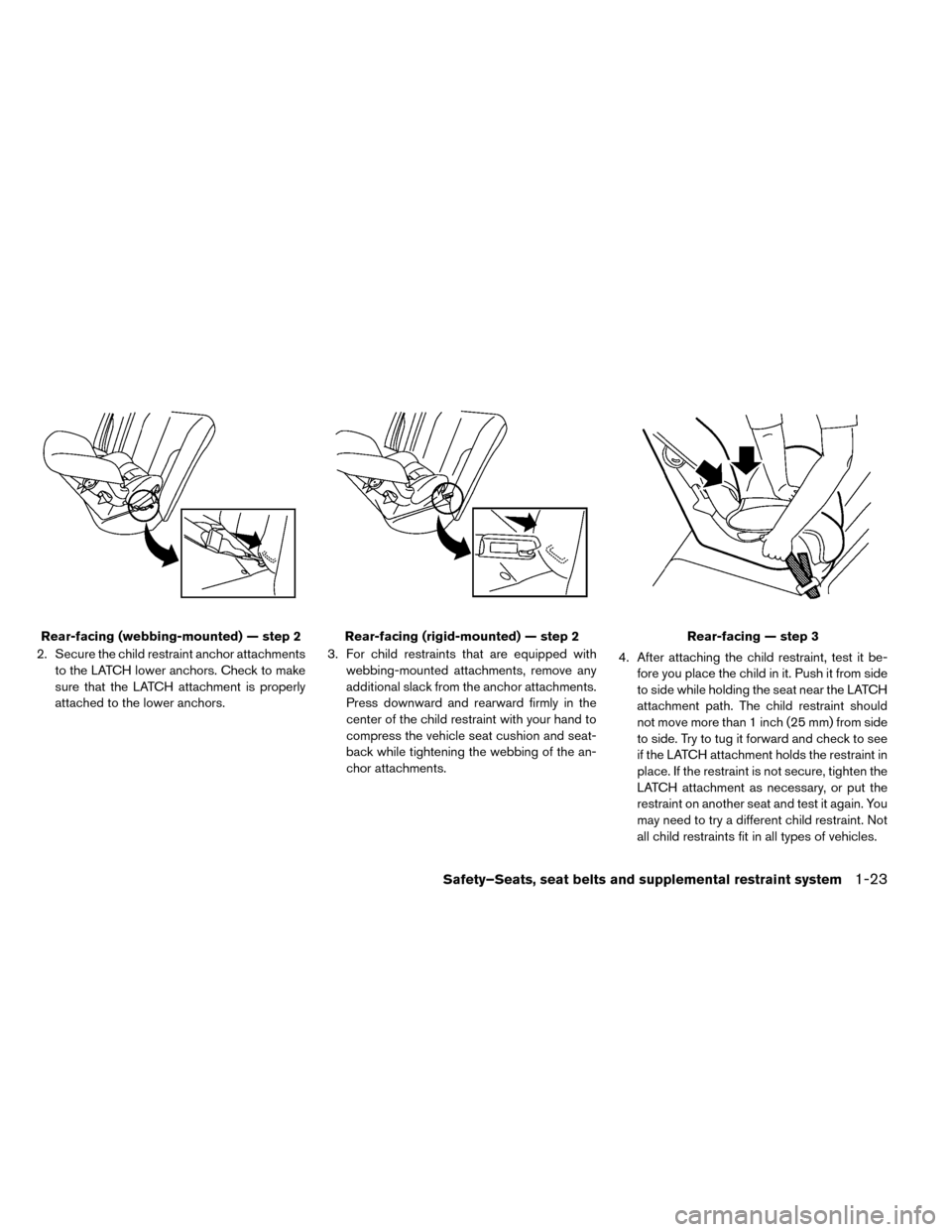
2. Secure the child restraint anchor attachmentsto the LATCH lower anchors. Check to make
sure that the LATCH attachment is properly
attached to the lower anchors. 3. For child restraints that are equipped with
webbing-mounted attachments, remove any
additional slack from the anchor attachments.
Press downward and rearward firmly in the
center of the child restraint with your hand to
compress the vehicle seat cushion and seat-
back while tightening the webbing of the an-
chor attachments. 4. After attaching the child restraint, test it be-
fore you place the child in it. Push it from side
to side while holding the seat near the LATCH
attachment path. The child restraint should
not move more than 1 inch (25 mm) from side
to side. Try to tug it forward and check to see
if the LATCH attachment holds the restraint in
place. If the restraint is not secure, tighten the
LATCH attachment as necessary, or put the
restraint on another seat and test it again. You
may need to try a different child restraint. Not
all child restraints fit in all types of vehicles.
Rear-facing (webbing-mounted) — step 2Rear-facing (rigid-mounted) — step 2Rear-facing — step 3
Safety–Seats, seat belts and supplemental restraint system1-23
Page 111 of 412
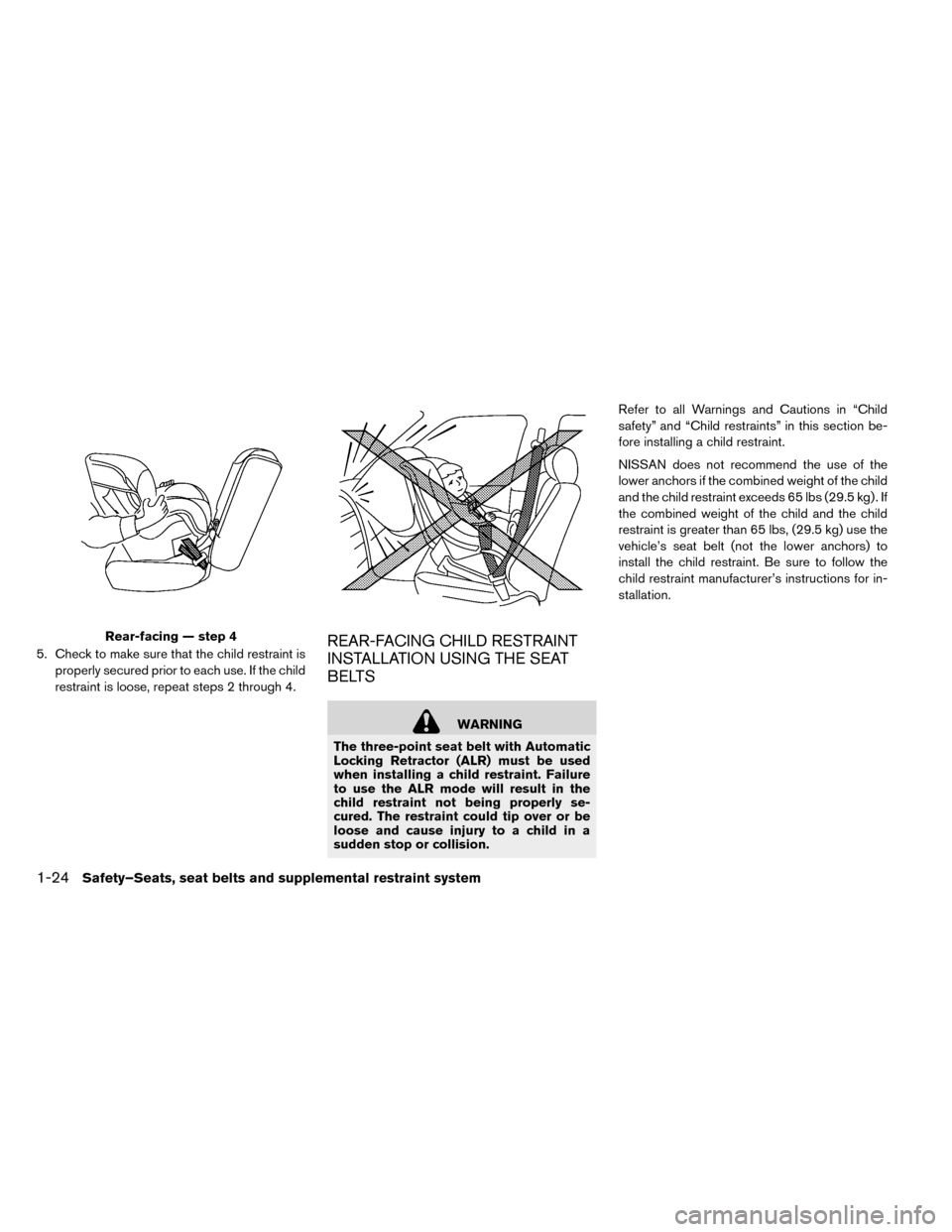
5. Check to make sure that the child restraint isproperly secured prior to each use. If the child
restraint is loose, repeat steps 2 through 4.REAR-FACING CHILD RESTRAINT
INSTALLATION USING THE SEAT
BELTS
WARNING
The three-point seat belt with Automatic
Locking Retractor (ALR) must be used
when installing a child restraint. Failure
to use the ALR mode will result in the
child restraint not being properly se-
cured. The restraint could tip over or be
loose and cause injury to a child in a
sudden stop or collision. Refer to all Warnings and Cautions in “Child
safety” and “Child restraints” in this section be-
fore installing a child restraint.
NISSAN does not recommend the use of the
lower anchors if the combined weight of the child
and the child restraint exceeds 65 lbs (29.5 kg) . If
the combined weight of the child and the child
restraint is greater than 65 lbs, (29.5 kg) use the
vehicle’s seat belt (not the lower anchors) to
install the child restraint. Be sure to follow the
child restraint manufacturer’s instructions for in-
stallation.
Rear-facing — step 4
1-24Safety–Seats, seat belts and supplemental restraint system
Page 113 of 412
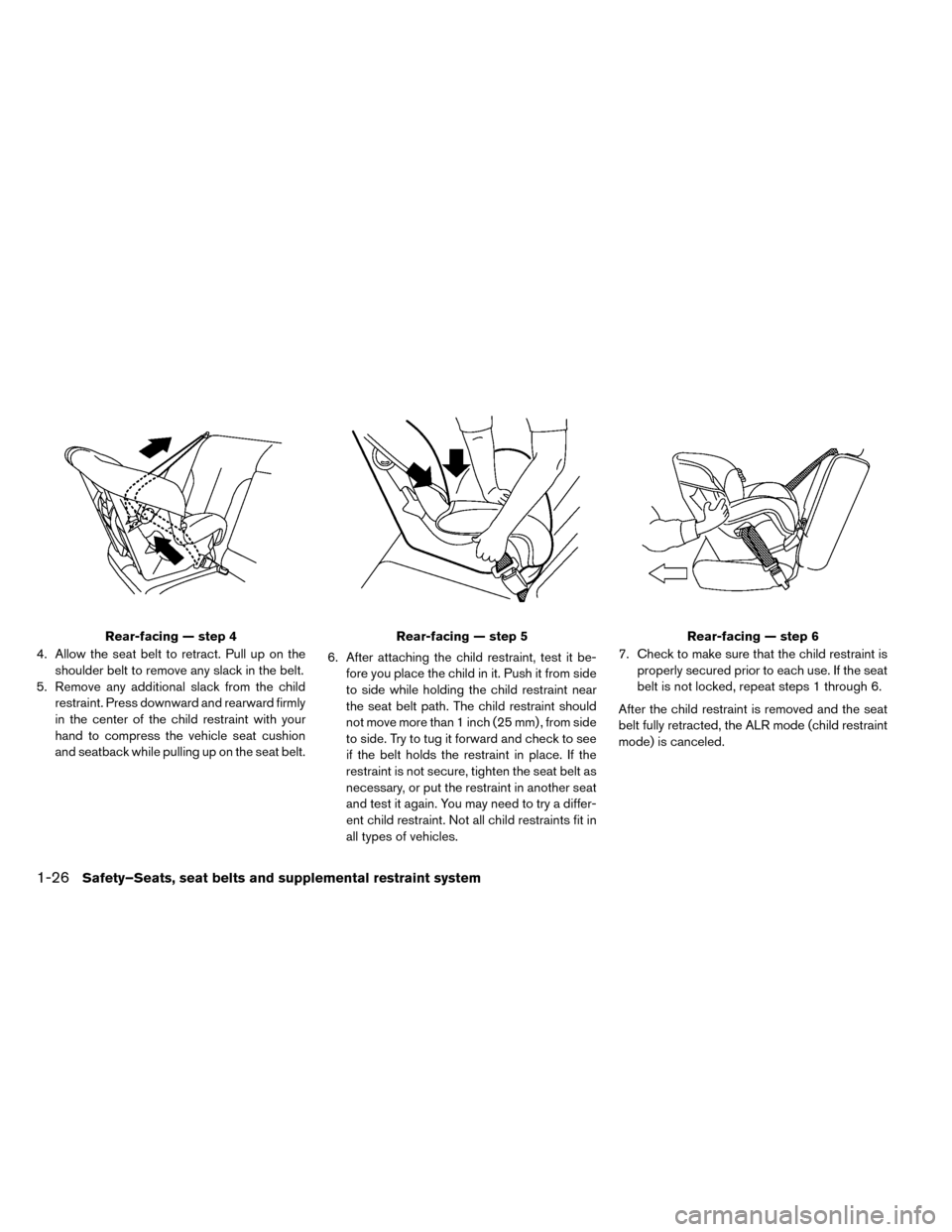
4. Allow the seat belt to retract. Pull up on theshoulder belt to remove any slack in the belt.
5. Remove any additional slack from the child restraint. Press downward and rearward firmly
in the center of the child restraint with your
hand to compress the vehicle seat cushion
and seatback while pulling up on the seat belt. 6. After attaching the child restraint, test it be-
fore you place the child in it. Push it from side
to side while holding the child restraint near
the seat belt path. The child restraint should
not move more than 1 inch (25 mm) , from side
to side. Try to tug it forward and check to see
if the belt holds the restraint in place. If the
restraint is not secure, tighten the seat belt as
necessary, or put the restraint in another seat
and test it again. You may need to try a differ-
ent child restraint. Not all child restraints fit in
all types of vehicles. 7. Check to make sure that the child restraint is
properly secured prior to each use. If the seat
belt is not locked, repeat steps 1 through 6.
After the child restraint is removed and the seat
belt fully retracted, the ALR mode (child restraint
mode) is canceled.
Rear-facing — step 4Rear-facing — step 5Rear-facing — step 6
1-26Safety–Seats, seat belts and supplemental restraint system
Page 114 of 412
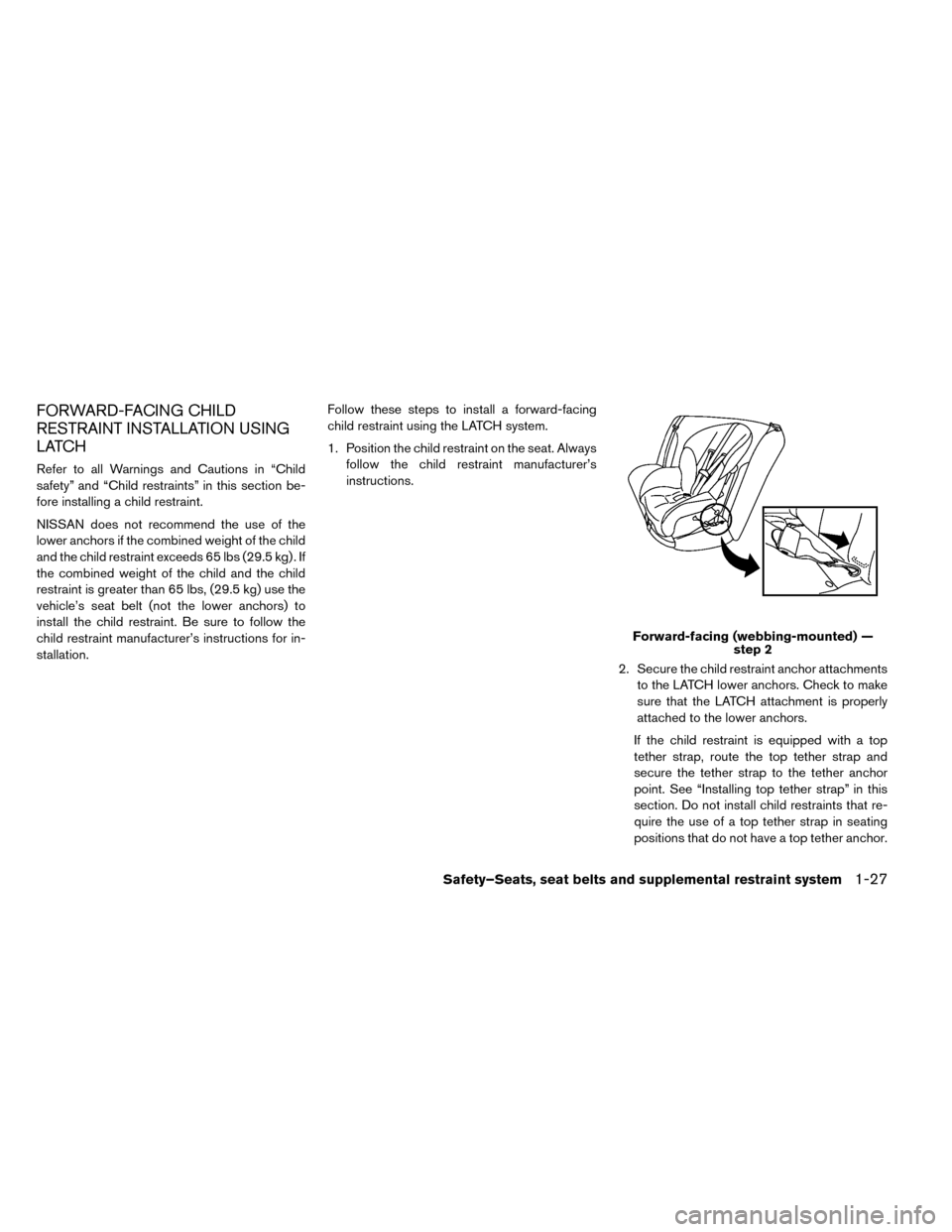
FORWARD-FACING CHILD
RESTRAINT INSTALLATION USING
LATCH
Refer to all Warnings and Cautions in “Child
safety” and “Child restraints” in this section be-
fore installing a child restraint.
NISSAN does not recommend the use of the
lower anchors if the combined weight of the child
and the child restraint exceeds 65 lbs (29.5 kg) . If
the combined weight of the child and the child
restraint is greater than 65 lbs, (29.5 kg) use the
vehicle’s seat belt (not the lower anchors) to
install the child restraint. Be sure to follow the
child restraint manufacturer’s instructions for in-
stallation.Follow these steps to install a forward-facing
child restraint using the LATCH system.
1. Position the child restraint on the seat. Always
follow the child restraint manufacturer’s
instructions.
2. Secure the child restraint anchor attachmentsto the LATCH lower anchors. Check to make
sure that the LATCH attachment is properly
attached to the lower anchors.
If the child restraint is equipped with a top
tether strap, route the top tether strap and
secure the tether strap to the tether anchor
point. See “Installing top tether strap” in this
section. Do not install child restraints that re-
quire the use of a top tether strap in seating
positions that do not have a top tether anchor.
Forward-facing (webbing-mounted) — step 2
Safety–Seats, seat belts and supplemental restraint system1-27
Page 115 of 412
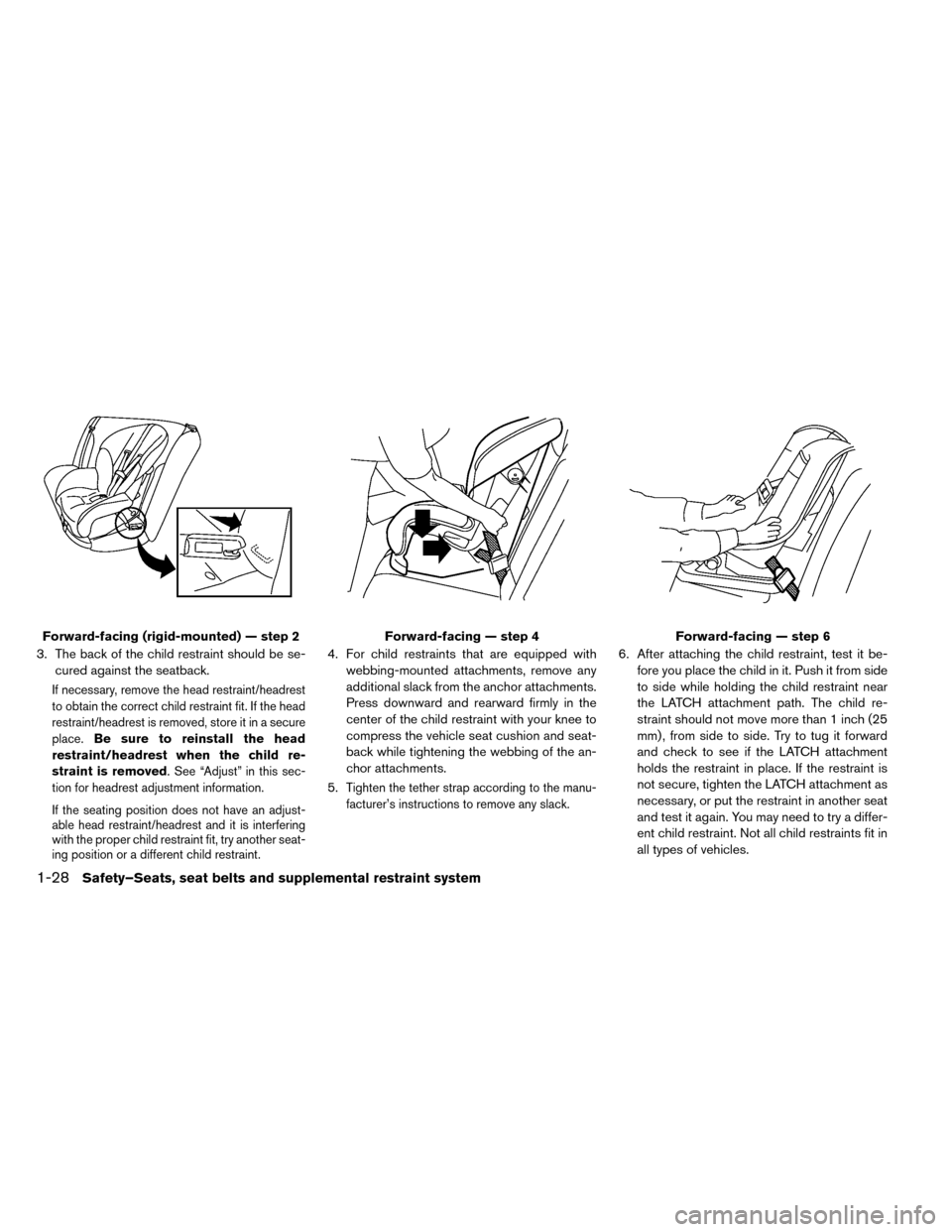
3. The back of the child restraint should be se-cured against the seatback.
If necessary, remove the head restraint/headrest
to obtain the correct child restraint fit. If the head
restraint/headrest is removed, store it in a secure
place.
Be sure to reinstall the head
restraint/headrest when the child re-
straint is removed.
See “Adjust” in this sec-
tion for headrest adjustment information.
If the seating position does not have an adjust-
able head restraint/headrest and it is interfering
with the proper child restraint fit, try another seat-
ing position or a different child restraint.
4. For child restraints that are equipped with webbing-mounted attachments, remove any
additional slack from the anchor attachments.
Press downward and rearward firmly in the
center of the child restraint with your knee to
compress the vehicle seat cushion and seat-
back while tightening the webbing of the an-
chor attachments.
5.
Tighten the tether strap according to the manu-
facturer’s instructions to remove any slack.
6. After attaching the child restraint, test it be- fore you place the child in it. Push it from side
to side while holding the child restraint near
the LATCH attachment path. The child re-
straint should not move more than 1 inch (25
mm) , from side to side. Try to tug it forward
and check to see if the LATCH attachment
holds the restraint in place. If the restraint is
not secure, tighten the LATCH attachment as
necessary, or put the restraint in another seat
and test it again. You may need to try a differ-
ent child restraint. Not all child restraints fit in
all types of vehicles.
Forward-facing (rigid-mounted) — step 2Forward-facing — step 4Forward-facing — step 6
1-28Safety–Seats, seat belts and supplemental restraint system
Page 116 of 412
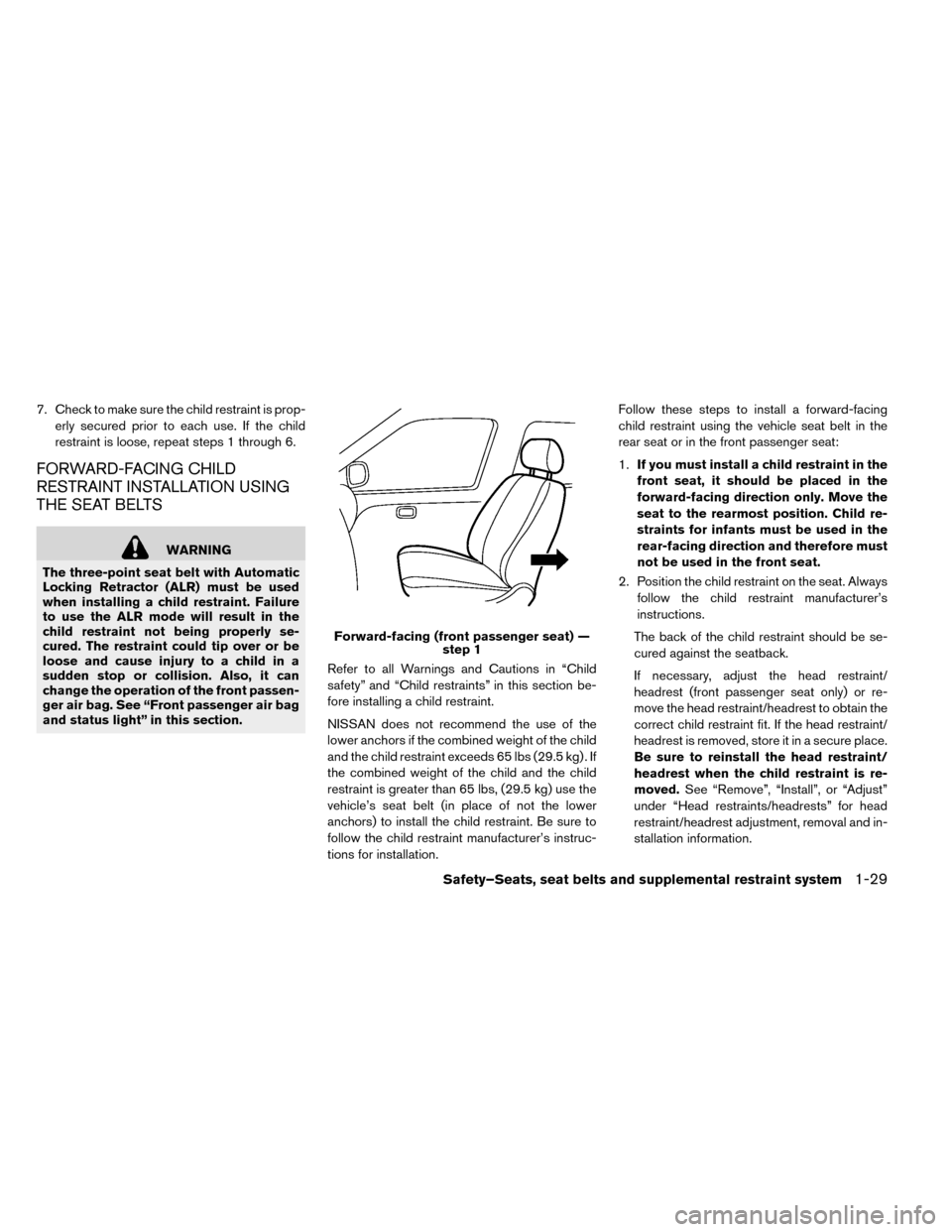
7. Check to make sure the child restraint is prop-erly secured prior to each use. If the child
restraint is loose, repeat steps 1 through 6.
FORWARD-FACING CHILD
RESTRAINT INSTALLATION USING
THE SEAT BELTS
WARNING
The three-point seat belt with Automatic
Locking Retractor (ALR) must be used
when installing a child restraint. Failure
to use the ALR mode will result in the
child restraint not being properly se-
cured. The restraint could tip over or be
loose and cause injury to a child in a
sudden stop or collision. Also, it can
change the operation of the front passen-
ger air bag. See “Front passenger air bag
and status light” in this section. Refer to all Warnings and Cautions in “Child
safety” and “Child restraints” in this section be-
fore installing a child restraint.
NISSAN does not recommend the use of the
lower anchors if the combined weight of the child
and the child restraint exceeds 65 lbs (29.5 kg) . If
the combined weight of the child and the child
restraint is greater than 65 lbs, (29.5 kg) use the
vehicle’s seat belt (in place of not the lower
anchors) to install the child restraint. Be sure to
follow the child restraint manufacturer’s instruc-
tions for installation. Follow these steps to install a forward-facing
child restraint using the vehicle seat belt in the
rear seat or in the front passenger seat:
1.
If you must install a child restraint in the
front seat, it should be placed in the
forward-facing direction only. Move the
seat to the rearmost position. Child re-
straints for infants must be used in the
rear-facing direction and therefore must
not be used in the front seat.
2. Position the child restraint on the seat. Always follow the child restraint manufacturer’s
instructions.
The back of the child restraint should be se-
cured against the seatback.
If necessary, adjust the head restraint/
headrest (front passenger seat only) or re-
move the head restraint/headrest to obtain the
correct child restraint fit. If the head restraint/
headrest is removed, store it in a secure place.
Be sure to reinstall the head restraint/
headrest when the child restraint is re-
moved. See “Remove”, “Install”, or “Adjust”
under “Head restraints/headrests” for head
restraint/headrest adjustment, removal and in-
stallation information.
Forward-facing (front passenger seat) — step 1
Safety–Seats, seat belts and supplemental restraint system1-29
Page 117 of 412
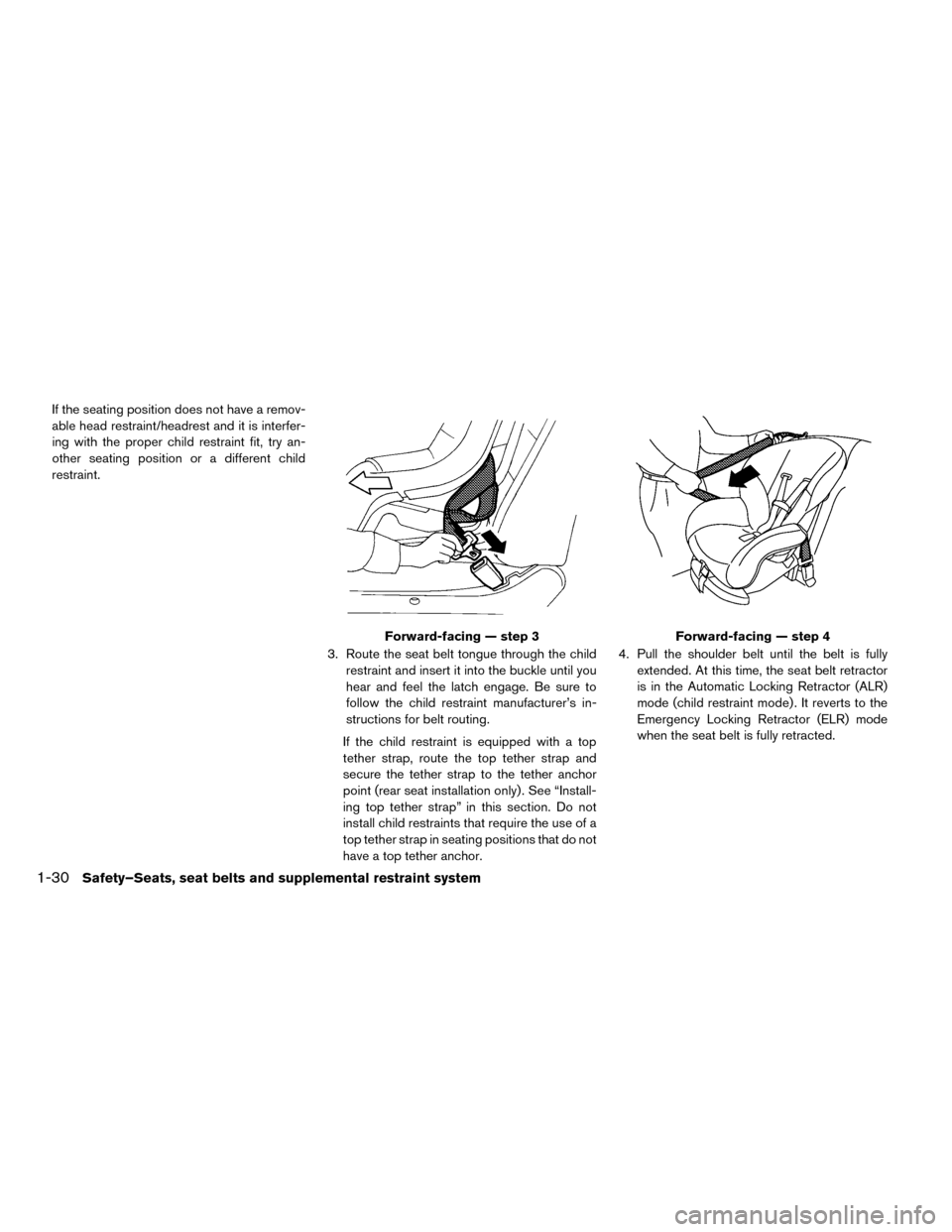
If the seating position does not have a remov-
able head restraint/headrest and it is interfer-
ing with the proper child restraint fit, try an-
other seating position or a different child
restraint.3. Route the seat belt tongue through the childrestraint and insert it into the buckle until you
hear and feel the latch engage. Be sure to
follow the child restraint manufacturer’s in-
structions for belt routing.
If the child restraint is equipped with a top
tether strap, route the top tether strap and
secure the tether strap to the tether anchor
point (rear seat installation only) . See “Install-
ing top tether strap” in this section. Do not
install child restraints that require the use of a
top tether strap in seating positions that do not
have a top tether anchor. 4. Pull the shoulder belt until the belt is fully
extended. At this time, the seat belt retractor
is in the Automatic Locking Retractor (ALR)
mode (child restraint mode) . It reverts to the
Emergency Locking Retractor (ELR) mode
when the seat belt is fully retracted.
Forward-facing — step 3Forward-facing — step 4
1-30Safety–Seats, seat belts and supplemental restraint system